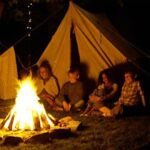We usually take it for granted that our readers have some background knowledge about camping. While this is mostly true, there must be some of you reading this that haven’t touched a sleeping bag since your last elementary school sleepover. Now that it is spring, camping curious people start to consider packing up a backpack and heading to the woods for a night. And we want you to be prepared for your first experience. Camping tents are essential for a campout, and the tent jargon can be utterly confusing. Here’s your handy guide to deciphering the tent language so you can buy the shelter perfect for your needs.

Shape
There are a few major types of tent “shapes” that you might find. The main one is the “dome” tent. The standard, modern tent is a dome, and these come in all sizes and purposes. Typically, the dome tent has at least two long poles that cross in an “x” shape across the tent. If you are camping alone or want a light load, a bivy shelter might catch your eye. Bivies look like a tent in the shape of a sleeping bag – and that’s exactly what they are. The tent will be barely taller than you, when you’re lying down, so there is little moving room. These should not be confused with bivy sacks, which lack the tent-like poles. The third major tent shape that you might run into is, simply, the “shelter.” Shelters are not camping tents, so much as they are sun shelters. These are usually sideless, but they can cover your sleeping area, or even cover your car.
Season
Tents always include a season title to let the camper know how many season the tent can be used in. There are 2-season tents, although they are not very common. These are very basic, lightweight tents meant for warm weather conditions. 3-season tents are the most common. They provide shelter through spring, summer, and autumn, and are moderately ventilated. 4-season tents will let you camp in winter; they differ from 3-season tents by having a “double-wall,” which blocks winter wind, and having little ventilation. Frequently they will also come up snow stakes.

Capacity
A tent’s capacity will let you know how many people it will sleep. Many campers recommend getting a tent that fits one more than will actually sleep inside. This gives adequate room to store gear inside. Remember, if you are hiking or backpacking, a larger capacity tent is heavier.
Use
A tent’s use is vague. However, you should keep in mind the activities on which you will bring the shelter. If you’re going on a long backpacking trip, a lightweight tent is a necessity. If you plan to car camp, a large tent or even a car tent are options. Talk with your sale’s person or, if you’re shopping online, call the customer service and discuss with them your camping intentions.



